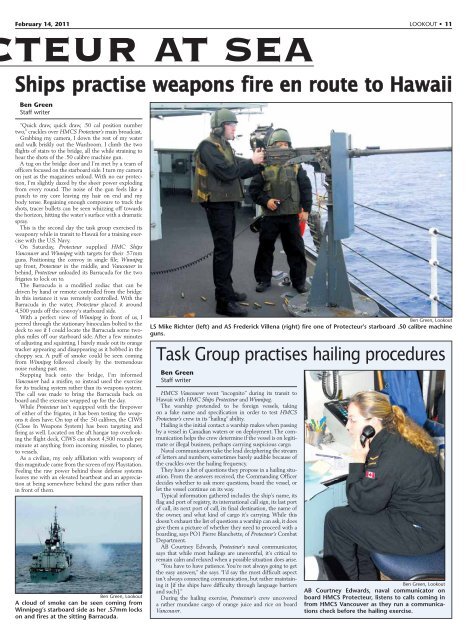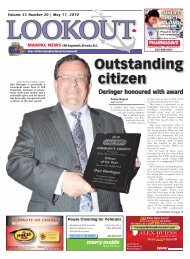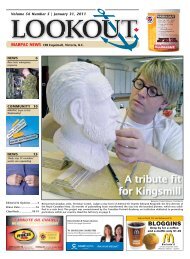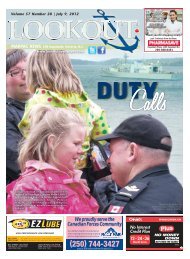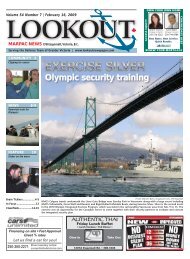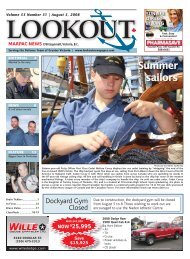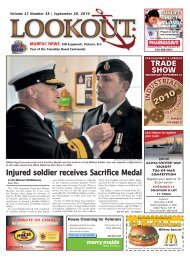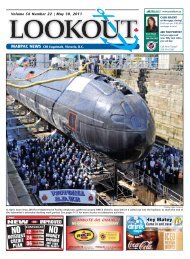Adding history to tribute - Lookout Newspaper
Adding history to tribute - Lookout Newspaper
Adding history to tribute - Lookout Newspaper
Create successful ePaper yourself
Turn your PDF publications into a flip-book with our unique Google optimized e-Paper software.
February 14, 2011 LOOKOUT • 11<br />
TEUR AT SEA<br />
Ships practise weapons fire en route <strong>to</strong> Hawaii<br />
Ben Green<br />
Staff writer<br />
“Quick draw, quick draw, .50 cal position number<br />
two,” crackles over HMCS Protecteur’s main broadcast.<br />
Grabbing my camera, I down the rest of my water<br />
and walk briskly out the Wardroom. I climb the two<br />
flights of stairs <strong>to</strong> the bridge, all the while straining <strong>to</strong><br />
hear the shots of the .50 calibre machine gun.<br />
A tug on the bridge door and I’m met by a team of<br />
officers focused on the starboard side. I turn my camera<br />
on just as the magazines unload. With no ear protection,<br />
I’m slightly dazed by the sheer power exploding<br />
from every round. The noise of the gun feels like a<br />
punch <strong>to</strong> my core leaving my hair on end and my<br />
body tense. Regaining enough composure <strong>to</strong> track the<br />
shots, tracer bullets can be seen whizzing off <strong>to</strong>wards<br />
the horizon, hitting the water’s surface with a dramatic<br />
spray.<br />
This is the second day the task group exercised its<br />
weaponry while in transit <strong>to</strong> Hawaii for a training exercise<br />
with the U.S. Navy.<br />
On Saturday, Protecteur supplied HMC Ships<br />
Vancouver and Winnipeg with targets for their .57mm<br />
guns. Positioning the convoy in single file, Winnipeg<br />
up front, Protecteur in the middle, and Vancouver in<br />
behind, Protecteur unloaded its Barracuda for the two<br />
frigates <strong>to</strong> lock on <strong>to</strong>.<br />
The Barracuda is a modified zodiac that can be<br />
driven by hand or remote controlled from the bridge.<br />
In this instance it was remotely controlled. With the<br />
Barracuda in the water, Protecteur placed it around<br />
4,500 yards off the convoy’s starboard side.<br />
With a perfect view of Winnipeg in front of us, I<br />
peered through the stationary binoculars bolted <strong>to</strong> the<br />
deck <strong>to</strong> see if I could locate the Barracuda some twoplus<br />
miles off our starboard side. After a few minutes<br />
of adjusting and squinting, I barely made out its orange<br />
tracker appearing and disappearing as it bobbed in the<br />
choppy sea. A puff of smoke could be seen coming<br />
from Winnipeg followed closely by the tremendous<br />
noise rushing past me.<br />
Stepping back on<strong>to</strong> the bridge, I’m informed<br />
Vancouver had a misfire, so instead used the exercise<br />
for its tracking system rather than its weapons system.<br />
The call was made <strong>to</strong> bring the Barracuda back on<br />
board and the exercise wrapped up for the day.<br />
While Protecteur isn’t equipped with the firepower<br />
of either of the frigates, it has been testing the weapons<br />
it does have. On <strong>to</strong>p of the .50 calibres, the CIWS<br />
(Close In Weapons System) has been targeting and<br />
firing as well. Located on the aft hangar <strong>to</strong>p overlooking<br />
the flight deck, CIWS can shoot 4,500 rounds per<br />
minute at anything from incoming missiles, <strong>to</strong> planes,<br />
<strong>to</strong> vessels.<br />
As a civilian, my only affiliation with weaponry of<br />
this magnitude came from the screen of my Playstation.<br />
Feeling the raw power behind these defense systems<br />
leaves me with an elevated heartbeat and an appreciation<br />
at being somewhere behind the guns rather than<br />
in front of them.<br />
Ben Green, <strong>Lookout</strong><br />
A cloud of smoke can be seen coming from<br />
Winnipeg’s starboard side as her .57mm locks<br />
on and fires at the sitting Barracuda.<br />
Ben Green, <strong>Lookout</strong><br />
LS Mike Richter (left) and AS Frederick Villena (right) fire one of Protecteur’s starboard .50 calibre machine<br />
guns.<br />
Task Group practises hailing procedures<br />
Ben Green<br />
Staff writer<br />
HMCS Vancouver went “incogni<strong>to</strong>” during its transit <strong>to</strong><br />
Hawaii with HMC Ships Protecteur and Winnipeg.<br />
The warship pretended <strong>to</strong> be foreign vessels, taking<br />
on a fake name and specification in order <strong>to</strong> test HMCS<br />
Protecteur’s crew in its “hailing” ability.<br />
Hailing is the initial contact a warship makes when passing<br />
by a vessel in Canadian waters or on deployment. The communication<br />
helps the crew determine if the vessel is on legitimate<br />
or illegal business, perhaps carrying suspicious cargo.<br />
Naval communica<strong>to</strong>rs take the lead deciphering the stream<br />
of letters and numbers, sometimes barely audible because of<br />
the crackles over the hailing frequency.<br />
They have a list of questions they propose in a hailing situation.<br />
From the answers received, the Commanding Officer<br />
decides whether <strong>to</strong> ask more questions, board the vessel, or<br />
let the vessel continue on its way.<br />
Typical information gathered includes the ship’s name, its<br />
flag and port of registry, its international call sign, its last port<br />
of call, its next port of call, its final destination, the name of<br />
the owner, and what kind of cargo it’s carrying. While this<br />
doesn’t exhaust the list of questions a warship can ask, it does<br />
give them a picture of whether they need <strong>to</strong> proceed with a<br />
boarding, says PO1 Pierre Blanchette, of Protecteur’s Combat<br />
Department.<br />
AB Courtney Edwards, Protecteur’s naval communica<strong>to</strong>r,<br />
says that while most hailings are uneventful, it’s critical <strong>to</strong><br />
remain calm and relaxed when a possible situation does arise.<br />
“You have <strong>to</strong> have patience. You’re not always going <strong>to</strong> get<br />
the easy answers,” she says. “I’d say the most difficult aspect<br />
isn’t always connecting communication, but rather maintaining<br />
it [if the ships have difficulty through language barriers<br />
and such].”<br />
During the hailing exercise, Protecteur’s crew uncovered<br />
a rather mundane cargo of orange juice and rice on board<br />
Vancouver.<br />
Ben Green, <strong>Lookout</strong><br />
AB Courtney Edwards, naval communica<strong>to</strong>r on<br />
board HMCS Protecteur, listens <strong>to</strong> calls coming in<br />
from HMCS Vancouver as they run a communications<br />
check before the hailing exercise.


